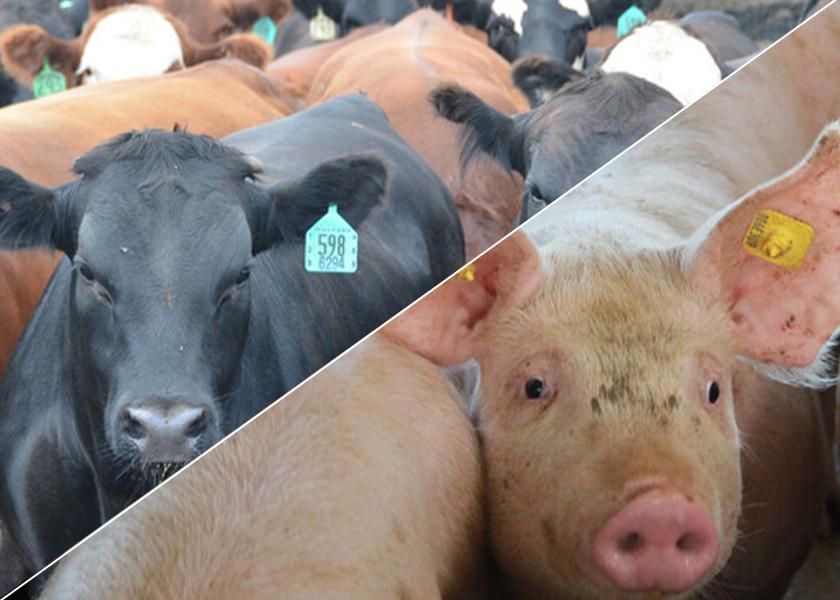Livestock Analysis | April 29, 2022

Price action: June lean hog futures tumbled $4.60 to $106.375, a three-month closing low and a $12.40 plunge for the week.
5-day outlook: Technically bearish weekly and monthly low closes in hog futures today sets the table for followthrough chart-based selling early next week. A bearish head-and-shoulders top reversal pattern in June futures indicates a downside price objective around $100.00. Slumping cash and wholesale pork markets are fueling the fundamental selling pressure in futures. Wholesale pork prices early today fell 17 cents to $104.32, the lowest since early April. Movement by midday was decent at 211.66 loads. Thursday’s preliminary figure for the CME Lean Hog Index is $101.77, down 4 cents from Wednesday’s quote. The five-day rolling average national direct cash hog price Friday is $97.69.
30-day outlook: Futures may eventually find a bottom with the market entering a period that typically brings seasonal strength as the summer grilling season approaches. A recent pick-up in U.S. pork export sales, if sustained, could also lend support to prices. USDA reported net weekly U.S. pork sales at more than double the marketing-year low the previous week and up 19% from the four-week average. High retail beef prices may limit downside price pressure for the near term.
90-day outlook: China’s apparent full recovery from its African swine fever outbreak has crimped U.S. pork exports to that nation. Still, USDA’s projection of dropping hog supplies and summer grilling demand could give hog prices a solid boost in the next few months.
What to do: Cover all soybean meal needs in the cash market through May. Be prepared to extend coverage on further price weakness. You are hand-to-mouth on corn-for-feed needs.
Hedgers: Carry all risk in the cash market for now.
Feed needs: You have all soybean meal needs covered in the cash market through May. Be prepared to extend coverage on price weakness. You are hand-to-mouth on corn-for-feed needs.
Price action: April live cattle futures, which expired today, rose $3.40 to $141.90. June live cattle dropped $1.25 to $132.65, a weekly loss of $5.775. May feeder futures fell $1.60 to $156.35, down $7.525 for the week.
5-day outlook: This week’s bearish breakdown in the wake of last Friday’s USDA Cattle on Feed report continued, with pessimism about spring-summer beef demand seeming to undercut futures despite the strong cash rebound from Monday’s early dive. Indeed, the Monday-Thursday five-area direct market average at $143.31 topped the comparable week-prior figure at $143.00. The big April futures surge to its noon final settlement reemphasized the cash firmness. This seems to bode well for cash strength over the next two weeks as grocers buy wholesale beef aggressively for Memorial Day weekend and the first weekend in June. Such sustained strength would probably rely upon renewed strength in choice beef values, which fell to a fresh five-week low of $261.49 early today. Futures’ near-term performance hinges in part on beef price direction. Sustained cash and/or beef price gains could spur a sizeable futures rebound next week.
30-day outlook: Memorial Day weekend is typically the biggest beef consumption weekend of the year, with Independence Day likely being the second most active. Thus, history strongly suggests retailers will be buying beef quite strongly over the next six weeks. The problem for producers and the packing industry remains the greatly elevated cost of beef in grocery stores, which is rather clearly stifling consumer demand. Still, spring grilling demand should provide considerable support for prices, but cattle prices traditionally move lower through spring as weekly cattle slaughter climbs to summer highs. Although this week’s futures losses seem to have developed substantial downward momentum, the 10-year average implying an approximate $11.00 cash-market drop from the spring high ($143.22) to early-summer lows (around $132.00) suggests June futures at today’s settlement have largely incorporated the seasonal decline. Thus, June futures may not have a great deal of downside risk from this point.
90-day outlook: In recent years, cash cattle prices have tended to stabilize in early-to-midsummer, then dip a bit further in late summer. This seemingly reflects comparatively large summer slaughter rates and diminished consumer demand amidst the summer doldrums. This may also be a result of the forward shift in start of the fall term at primary and secondary schools. That is, the school year used to start around Labor Day, but many schools now start their year in early-to-mid-August, which means the industry’s buying for school lunches probably starts that much earlier and seemingly leaves a bit of a demand hole when grocer buying for Labor Day features ends. Ultimately, the summer rebound implied by the August cattle futures premium over June may prove excessive.
What to do: Cover all soybean meal needs in the cash market through May. Be prepared to extend coverage on further price weakness. You are hand-to-mouth on corn-for-feed needs.
Hedgers: Carry all risk in the cash market for now.
Feed needs: You have all soybean meal needs covered in the cash market through May. Be prepared to extend coverage on price weakness. You are hand-to-mouth on corn-for-feed needs.






